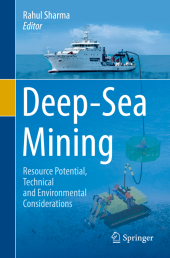 Neuerscheinungen 2018Stand: 2020-02-01 |
Schnellsuche
ISBN/Stichwort/Autor
|
Herderstraße 10
10625 Berlin
Tel.: 030 315 714 16
Fax 030 315 714 14
info@buchspektrum.de |

Rahul Sharma
Deep-Sea Mining
Resource Potential, Technical and Environmental Considerations
Herausgegeben von Sharma, Rahul
Softcover reprint of the original 1st ed. 2017. 2018. x, 535 S. 139 SW-Abb., 131 Farbabb., 113 Farbtabe
Verlag/Jahr: SPRINGER, BERLIN; SPRINGER INTERNATIONAL PUBLISHING 2018
ISBN: 3-319-84935-2 (3319849352)
Neue ISBN: 978-3-319-84935-5 (9783319849355)
Preis und Lieferzeit: Bitte klicken
This comprehensive book contains contributions from specialists who provide a complete status update along with outstanding issues encompassing different topics related to deep-sea mining. Interest in exploration and exploitation of deep-sea minerals is seeing a revival due to diminishing grades and increasing costs of processing of terrestrial minerals as well as availability of several strategic metals in seabed mineral resources; it therefore becomes imperative to take stock of various issues related to deep-sea mining.
The authors are experienced scientists and engineers from around the globe developing advanced technologies for mining and metallurgical extraction as well as performing deep sea exploration for several decades. They invite readers to learn about the resource potential of different deep-sea minerals, design considerations and development of mining systems, and the potential environmental impacts of mining in international waters.
Part 1 Deep-sea minerals - distribution characteristics and their resource potential.- Deep-sea mining: current status and future considerations.- Composition, formation, and occurrence of polymetallic nodules.- Marine Co-rich Ferromanganese Crust Deposits: Description and Formation, Occurrences and Distribution, Estimated World-wide Resources.- Seafloor Massive Sulfide deposits: distribution and prospecting.- Submarine phosphorites: the deposits of the Chatham Rise, New Zealand, off Namibia and Baja California, Mexico : origin, exploration, mining and environmental issues.- Predictive mapping of the nodule abundance and mineral resource estimation in the Clarion-Clipperton Zone using artificial neural networks and classical geostatistical methods.- Statistical Properties of Distribution of Manganese Nodules in Indian and Pacific Oceans and Their Applications in Assessing Commonality Levels and in Exploration Planning.- Assessment of distribution characteristics of polymetallic nodules and their implications on deep-sea mining.- Part 2 Deep-sea mining technology - concepts and applications.- Fundamental geotechnical considerations for design of deep-sea mining systems.- Concepts of deep-sea mining technologies.- An Application of Ocean Mining Technology - Deep Ocean Water Utilization.- Part 3 Metallurgical processing and their sustainable development.- Metallurgical Processing of Polymetallic Ocean Nodules.- Sustainable processing of deep-sea polymetallic nodules.- Sustainable Development and its Application to Mine Tailings of Deep Sea Minerals.- Part 4 Environmental concerns of impact of deep-sea mining.- Recent Developments in Environmental Impact Assessment with regard to Mining of Deep-Sea Mineral Resources.- Taxonomic Problems in Environmental Impact Assessment (EIA) linked to Ocean Mining and Possibility of New Technology Developments.- Part 5 Management strategy.- Development of environmental management plan for deep-sea mining.- The crafting of seabed mining ecosystem-based management
Dr. Rahul Sharma is a Chief Scientist at the National Institute of Oceanography in Goa, India. He received his PhD in Marine Science from Goa University in 1997. His research interests include development of underwater photography for deep-sea exploration, environmental impact assessment for deep-sea mining, and application of environmental data for deep-sea mining and environmental conservation.


